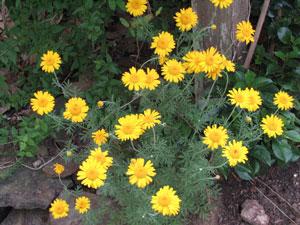Resource Library
Plant of the Week: Marguerite, Golden
The University of Arkansas System Division of Agriculture does not promote, support or recommend plants featured in "Plant of the Week." Please consult your local Extension office for plants suitable for your region.
Plant of the Week
Golden Marguerite
Latin: Anthemis tinctoria

Over the past 30 years I’ve grown hundreds of plants from the North American Rock Garden Society seed exchange. Theirs is a bare bones seed list, with only the Latin name, usually a guess to how tall the plant grows, and occasionally a cryptic reference to flower color. I usually order plants I’ve never heard of, which is interesting, but not an especially good way of stocking your rock garden. My overall success rate is low, but occasionally I find a plant I like, such as Golden Marguerite, Anthemis tinctoria.
Golden marguerite, also known as golden chamomile or oxeye chamomile, is a perennial herb in the daisy family that is native to Southern Europe. It grows about 2 feet tall and forms a slowly expanding clump. It has attractive gray-green aromatic leaves that are finely divided and fern-like, with white pubescence on the underside of the leaf.
Golden marguerite flowers have a typical oxeye daisy form and are produced singly at the ends of the stem. The golden-yellow ray flowers (the petals of the daisy) form a single row and surround a domed cushion of disk florets. For me, plants begin blooming in late May and continue on and off during the summer, but they never produce as good a display as seen in late spring. Deadheading improves repeat blooming.
The genus name is taken from a Greek word used to indicate a free-flowering plant. The species epitaph indicates that the flowers were used as a source for yellow dyes. The name chamomile is an old Greek name for Chamomilla recutita (the source plant for chamomile tea), but as a common name it has been used to describe many other lookalike daisy plants. In the 1633 edition of Gerard’s herbal, both the names of Anthemis and chamomile are used, but as far as I can find, not the name marguerite. In an early reference to the difficulty of discerning the differences between the many members of the daisy family, he says, “To distinguish the kinds of chamomile with sundry descriptions would be but to enlarge the volume, and small profit would thereby rebound to the reader.”
The name marguerite is a French name for daisy, and has been used to describe plants and is used as a woman’s name, which in English is Margaret. The most common “marguerite daisy” in gardens today is not Anthemis tinctoria but the frost tender, semi-woody daisy from the Canary Islands, Argyranthemum frutescens.
The genus Anthemis consists of about 100 species of European and Central Asian herbs, some of which have become established as roadside weeds throughout the world. The most common of these is dog-fennel or mayweed, Anthemis cotula, which has inch-wide white daisy flowers. It is established as an escaped weed in every state. The USDA reports A. tinctoria as escaped in mountainous regions and in most of our northern states, but not in the South.
Golden marguerite is a bit tall for the rock garden, but is useful as a perennial in areas that receive only natural rainfall. It makes a good cut flower. This plant needs lots of light and good drainage, especially during the winter months. It does best in low-fertility sites. Too much fertility makes for exuberant growth that makes the plant tall and floppy. Plants should be divided every few years to keep the clump vigorous. Several cultivars are listed, but they are not common in the trade.
By: Gerald Klingaman, retired
Retired Extension Horticulturist - Ornamentals
Extension News - August 19, 2011
The University of Arkansas System Division of Agriculture does not maintain lists of retail outlets where these plants can be purchased. Please check your local nursery or other retail outlets to ask about the availability of these plants for your growing area.